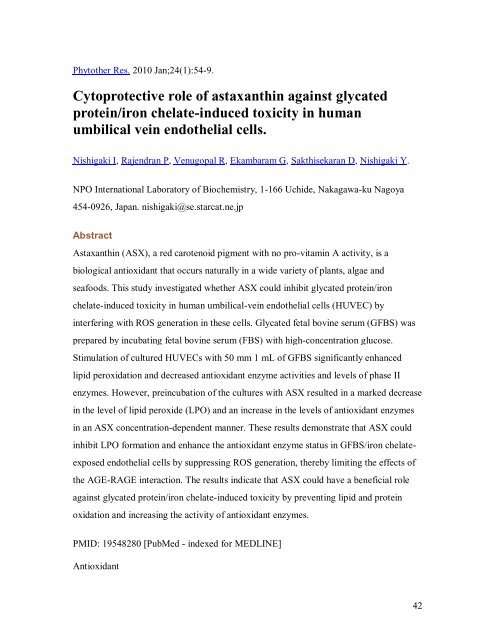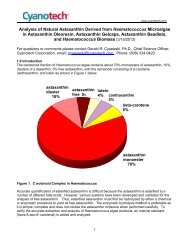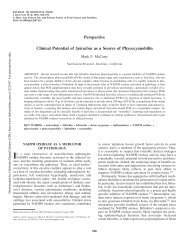- Page 1 and 2: The Medical Research of Astaxanthin
- Page 3 and 4: Introduction The body of medical re
- Page 5 and 6: Adapted from Nishida, Yamashita, Mi
- Page 7 and 8: OXYGEN FREE RADICAL SCAVENGING ABIL
- Page 9 and 10: Phytother Res. 2009 Jun 22. [Epub a
- Page 11 and 12: Chem Biol Interact. 2009 Aug 14;180
- Page 13 and 14: J Nutr Biochem. 2009 May 6. [Epub a
- Page 15 and 16: Phys Chem A. 2008 Sep 25;112(38):90
- Page 17 and 18: Biochem Biophys Res Commun. 2007 Ma
- Page 19 and 20: Luminescence. 2005 Nov-Dec;20(6):41
- Page 21 and 22: Chem Phys Lipids. 2001 Nov;113(1-2)
- Page 23 and 24: Arch Biochem Biophys. 2001 Jan 1;38
- Page 25 and 26: Biochim Biophys Acta. 2000 Jan 15;1
- Page 27 and 28: J Nutr Sci Vitaminol (Tokyo). 1997
- Page 29 and 30: Arch Biochem Biophys. 1992 Sep;297(
- Page 31 and 32: Physiol Chem Phys Med NMR. 1990;22(
- Page 33 and 34: Critical Reviews in Food Science an
- Page 35 and 36: Pure & Appl. Chem., Vol. 63, No. 1,
- Page 37 and 38: Int. J. Vitam. Nutr. Res., 77(1), 2
- Page 39 and 40: Reprod Domest Anim. 2009 Nov 18. [E
- Page 41: Antioxidant Eur J Nutr. 2010 Apr 2.
- Page 45 and 46: Can J Physiol Pharmacol. 2010 Oct;8
- Page 47 and 48: J Clin Biochem Nutr. 2010 Sep;47(2)
- Page 49 and 50: Eur J Nutr. 2011 Oct 5. [Epub ahead
- Page 51 and 52: J Nutr. 2011 Sep;141(9):1611-7. Epu
- Page 53 and 54: Yao Xue Xue Bao. 2011 May;46(5):521
- Page 55 and 56: Reprod Domest Anim. 2010 Dec;45(6):
- Page 57 and 58: Br J Nutr. 2010 Oct;104(7):980-8. E
- Page 59 and 60: Mutat Res. 2010 Feb;696(1):69-80. E
- Page 61 and 62: Methods Mol Biol. 2010;594:263-73.
- Page 63 and 64: Toxicology. 2008 Jun 27;248(2-3):96
- Page 65 and 66: The effects of oral Cardax (disodiu
- Page 67 and 68: Anti-Inflammatory Mol Cells. 2003 A
- Page 69 and 70: Biol Pharm Bull. 2004 Feb;27(2):170
- Page 71 and 72: Trends Biotechnol. 2003 May;21(5):2
- Page 73 and 74: Effect of daily use natural astaxan
- Page 75 and 76: Effect of Astaxanthin on Muscular A
- Page 77 and 78: Long term dietary antioxidant intak
- Page 79 and 80: Effect of daily use of natural asta
- Page 81 and 82: Phytother Res. 2010 Jul 14. [Epub a
- Page 83 and 84: J Biol Chem. 2009 Oct 9;284(41):281
- Page 85 and 86: Skin Health Carotenoid Science Vol
- Page 87 and 88: J Dermatol Sci. 2002 Oct;30(1):73-8
- Page 89 and 90: Int J Vitam Nutr Res. 1995;65(2):79
- Page 91 and 92: (Adapted from Nutrition Business Jo
- Page 93 and 94:
Journal of Cosmetic Dermatology Vol
- Page 95 and 96:
Photoprotective Effect of Astaxanth
- Page 97 and 98:
Journal of Japanese Cosmetic Scienc
- Page 99 and 100:
Journal of Japanese Cosmetic Scienc
- Page 101 and 102:
Plant Physiol Biochem. 2008 Oct;46(
- Page 103 and 104:
Journal of Clinical Therapeutics &
- Page 105 and 106:
J Pharm Pharmacol. 2008 Oct;60(10):
- Page 107 and 108:
Nippon Ganka Gakkai Zasshi. 2009 Ma
- Page 109 and 110:
Ophthalmology. 2008 Feb;115(2):324-
- Page 111 and 112:
J Agric Food Chem. 2006 Mar 22;54(6
- Page 113 and 114:
J Nutr. 2004 Dec;134(12):3225-32. X
- Page 115 and 116:
Journal of Clinical Therapeutics &
- Page 117 and 118:
Journal of Clinical Therapeutics &
- Page 119 and 120:
Atarashii Ganka, 25(10):1461-1464 (
- Page 121 and 122:
Journal of Traditional Medicines 20
- Page 123 and 124:
Journal of Clinical Therapeutics &
- Page 125 and 126:
Regul Toxicol Pharmacol. 2010 Oct;5
- Page 127 and 128:
J Pharm Pharmacol. 2008 Oct;60(10):
- Page 129 and 130:
FASEB J. 2009 Jun;23(6):1958-68. Ep
- Page 131 and 132:
Brain Res. 2009 Feb 13;1254:18-27.
- Page 133 and 134:
Alcohol Clin Exp Res. 2008 Aug;32(8
- Page 135 and 136:
Effects of astaxanthin on brain dam
- Page 137 and 138:
Food Chem Toxicol. 2010 Jun;48(6):1
- Page 139 and 140:
J Clin Biochem Nutr. 2009 May;44(3)
- Page 141 and 142:
J Clin Biochem Nutr. 2010 Sep;47(2)
- Page 143 and 144:
Brain Res. 2010 Sep 21. [Epub ahead
- Page 145 and 146:
Pharmacol Biochem Behav. 2011 Sep;9
- Page 147 and 148:
Food Chem Toxicol. 2011 Jan;49(1):2
- Page 149 and 150:
Cardioprotective Atherosclerosis. 2
- Page 151 and 152:
Am J Cardiol. 2008 May 22;101(10A):
- Page 153 and 154:
Int J Vitam Nutr Res. 2007 Jan;77(1
- Page 155 and 156:
J Clin Biochem Nutr. 2008 Sep;43(2)
- Page 157 and 158:
Arzneimittelforschung. 2007;57(1):2
- Page 159 and 160:
J Cardiovasc Pharmacol. 2006;47 Sup
- Page 161 and 162:
J Nat Prod. 2006 Mar;69(3):443-9. A
- Page 163 and 164:
Mol Cell Biochem. 2006 Feb;283(1-2)
- Page 165 and 166:
Arzneimittelforschung. 2005;55(6):3
- Page 167 and 168:
Biol Pharm Bull. 2005 Jun;28(6):967
- Page 169 and 170:
Biol Pharm Bull. 2005 Jan;28(1):47-
- Page 171 and 172:
Life Sci. 2004 May 28;75(2):215-24.
- Page 173 and 174:
Biull Eksp Biol Med. 1997 Mar;123(3
- Page 175 and 176:
Review Future Cardiology www.future
- Page 177 and 178:
Antioxid Redox Signal. 2003 Feb;5(1
- Page 179 and 180:
Biosci Biotechnol Biochem. 2007 Apr
- Page 181 and 182:
Biol Pharm Bull S0989A 0918-6158 VO
- Page 183 and 184:
JOURNAL OF FUNCTIONAL FOODS 1 (2009
- Page 185 and 186:
J of the Pharmaceutical Society of
- Page 187 and 188:
Pharmacol Res. 2010 Sep 22. [Epub a
- Page 189 and 190:
Eur J Nutr. 2010 Mar;49(2):119-26.
- Page 191 and 192:
Thromb Res. 2010 Oct;126(4):299-305
- Page 193 and 194:
J Cardiovasc Pharmacol Ther. 2009 D
- Page 195 and 196:
Atherosclerosis. 2010 Apr;209(2):52
- Page 197 and 198:
Integr Blood Press Control. 2008;1:
- Page 199 and 200:
Experimental Biology Saturday, Apri
- Page 201 and 202:
Nutr Cancer. 1996;26(3):313-24. Eff
- Page 203 and 204:
Br Poult Sci. 2007 Feb;48(1):90-7.
- Page 205 and 206:
Fish Shellfish Immunol. 2004 Apr;16
- Page 207 and 208:
J Nutr. 1995 Oct;125(10):2483-92. A
- Page 209 and 210:
Nutr Cancer. 1994;21(1):47-58. Immu
- Page 211 and 212:
Nutr Cancer. 1991;16(2):93-105. Stu
- Page 213 and 214:
NUTRITION AND CANCER, 36(1), 59-65
- Page 215 and 216:
Vet Immunol Immunopathol. 2011 Sep
- Page 217 and 218:
Cancer Prevention and Tumor Reducti
- Page 219 and 220:
Mol Nutr Food Res. 2006 Nov;50(11):
- Page 221 and 222:
Int J Mol Med. 2005 Nov;16(5):931-6
- Page 223 and 224:
Carcinogenesis. 2005 Sep;26(9):1634
- Page 225 and 226:
Life Sci. 2002 Apr 21;70(21):2509-2
- Page 227 and 228:
Cancer Lett. 2000 Apr 3;151(1):111-
- Page 229 and 230:
Anticancer Res. 1999 May-Jun;19(3A)
- Page 231 and 232:
Carcinogenesis. 1998 Mar;19(3):403-
- Page 233 and 234:
J Cell Biochem Suppl. 1997;27:35-41
- Page 235 and 236:
Cancer Res. 1995 Sep 15;55(18):4059
- Page 237 and 238:
Autoimmunity. 1993;16(2):95-102. Pr
- Page 239 and 240:
Journal of Kyoto Prefectural Univer
- Page 241 and 242:
Pure & Appl. Chem. 71, 2273 (1999).
- Page 243 and 244:
J Herb Pharmacother. 2005;5(1):17-2
- Page 245 and 246:
carcinogenesis by modulating the ex
- Page 247 and 248:
Cancer Lett. 2009 Sep 28;283(1):108
- Page 249 and 250:
Anticancer Res. 2010 Jun;30(6):2171
- Page 251 and 252:
Biol Pharm Bull. 2011;34(6):839-44.
- Page 253 and 254:
Diabetes Life Sci. 2007 Jan 16;80(6
- Page 255 and 256:
Int J Vitam Nutr Res. 2008 Jul-Sep;
- Page 257 and 258:
Int J Mol Med. 2006 Oct;18(4):685-9
- Page 259 and 260:
Redox Rep. 2002;7(5):290-3. Astaxan
- Page 261 and 262:
Chem Biol Interact. 2010 Aug 5;186(
- Page 263 and 264:
Arch Oral Biol. 2010 Jul;55(7):479-
- Page 265 and 266:
Arzneimittelforschung. 2011;61(4):2
- Page 267 and 268:
Int Immunopharmacol. 2011 Jan;11(1)
- Page 269 and 270:
Ulcers and Gastrointestinal Health
- Page 271 and 272:
Eur J Pharmacol. 2008 Aug 20;590(1-
- Page 273 and 274:
FEMS Immunol Med Microbiol. 2007 Ju
- Page 275 and 276:
Biosci Biotechnol Biochem. 2005 Jul
- Page 277 and 278:
Antimicrob Agents Chemother. 2000 S
- Page 279 and 280:
Antimicrob Agents Chemother. 2000 S
- Page 281 and 282:
Applications for Athletes Int J Spo
- Page 283 and 284:
Biochem Biophys Res Commun. 2008 Fe
- Page 285 and 286:
Antioxid Redox Signal. 2003 Feb;5(1
- Page 287 and 288:
Mera Pharmaceuticals, Inc. Review p
- Page 289 and 290:
J Nutr Biochem. 2009 May 6. [Epub a
- Page 291 and 292:
Hiro to Kyuyo no Kagaku VOL.18;NO.1
- Page 293 and 294:
Long term dietary antioxidant intak
- Page 295 and 296:
Effects of Astaxanthin Ingestion on
- Page 297 and 298:
Recenti Prog Med. 2010 Apr;101(4):1
- Page 299 and 300:
Trends Biotechnol. 2003 May;21(5):2
- Page 301 and 302:
Copyright © 2002 by Mera Pharmaceu
- Page 303 and 304:
Methods Find Exp Clin Pharmacol. 20
- Page 305 and 306:
Toxicology. 2010 Jan 12;267(1-3):14
- Page 307 and 308:
Food Chem Toxicol. 2008 Jan;46(1):2
- Page 309 and 310:
Reprod Biomed Online. 2003 Oct-Nov;
- Page 311 and 312:
Asian J Androl. 2005 Sep;7(3):257-6
- Page 313 and 314:
Phytother Res. 2010 Jul 14. [Epub a
- Page 315 and 316:
Eur J Nutr. 2010 Apr 2. [Epub ahead
- Page 317 and 318:
Food Chem Toxicol. 2010 Jun;48(6):1
- Page 319 and 320:
AKVAFORSK (Inst. Aquaculture Resear
- Page 321 and 322:
Oxid Med Cell Longev. 2011;2011:596





